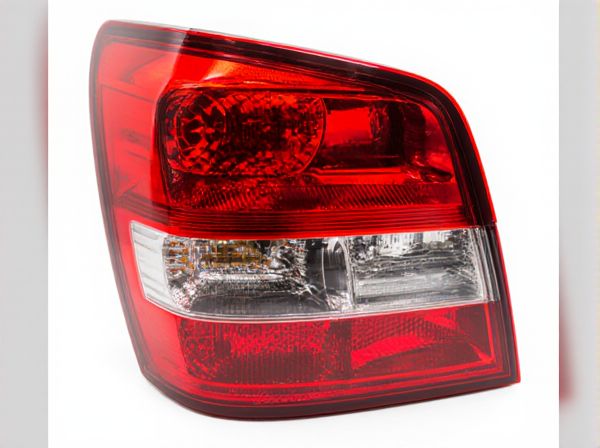
Photo illustration: Dynamic Taillight vs Fixed Pattern Taillight
Dynamic taillights enhance vehicle visibility by creating a flowing light effect, which improves signal clarity and modernizes your car's appearance. Fixed pattern taillights provide consistent illumination with simple on/off signals, ensuring reliable communication with other drivers. Choosing dynamic taillights can increase safety and style, while fixed patterns remain a cost-effective, straightforward option.
Table of Comparison
| Feature | Dynamic Taillight | Fixed Pattern Taillight |
|---|---|---|
| Lighting Type | Animated sequences with moving light | Static, unchanging light pattern |
| Visibility | Enhanced visibility through motion | Standard visibility without motion effects |
| Design Appeal | Modern and attention-grabbing | Traditional and simple |
| Energy Consumption | Typically higher due to animation | Lower, constant light output |
| Signal Clarity | Improved clarity with sequential lighting | Reliable but less dynamic signaling |
| Cost | Usually more expensive | Generally more affordable |
| Durability | Similar lifespan, but complex electronics | Long-lasting with simpler design |
Introduction to Taillight Technologies
Dynamic taillights use sequential LED arrays that create flowing light patterns, enhancing visibility and modern aesthetics compared to fixed pattern taillights that rely on static LED or incandescent bulbs. Advanced dynamic taillight systems improve signal clarity and vehicle safety by providing intuitive, eye-catching light sequences during braking or turning. Fixed pattern taillights remain popular due to lower cost and simpler design, but dynamic technology leads the automotive industry toward smarter, more responsive lighting solutions.
What is a Dynamic Taillight?
A dynamic taillight uses sequential LED lighting technology to create moving light patterns, enhancing vehicle visibility and signaling intentions more clearly. Unlike fixed pattern taillights, which illuminate a static design when activated, dynamic taillights present animated sequences that improve driver communication and road safety. This advanced lighting system is increasingly adopted in modern vehicles for its aesthetic appeal and functional advantages in signaling.
Understanding Fixed Pattern Taillights
Fixed pattern taillights feature a consistent illumination design that remains static during vehicle operation, providing clear and reliable signaling to other drivers. These taillights utilize LED or incandescent bulbs arranged in preset segments, ensuring uniform light distribution and easy recognition. Their simplicity enhances durability and reduces maintenance compared to dynamic taillights, which rely on sequential light patterns for signaling.
Key Features: Dynamic vs Fixed Pattern Taillights
Dynamic taillights feature sequential lighting patterns that enhance vehicle visibility and modern aesthetics, providing a clear indication of turns through smoothly flowing light signals. Fixed pattern taillights utilize static LED or incandescent bulbs that illuminate in a uniform, unchanging sequence, offering traditional, reliable signaling without animation. Dynamic designs improve road safety by capturing attention more effectively, while fixed patterns are simpler and more cost-efficient for standard vehicle applications.
Visibility and Safety: Which Offers Better Performance?
Dynamic taillights enhance visibility by emitting sequential lighting patterns that capture drivers' attention more effectively than fixed pattern taillights, improving reaction times in various driving conditions. Studies indicate that dynamic taillights reduce rear-end collision risks by increasing signal clarity during braking and lane changes. Fixed pattern taillights provide consistent illumination but lack the visual prominence and adaptability of dynamic systems, making dynamic designs superior for overall safety performance.
Design Flexibility and Aesthetics Comparison
Dynamic taillights offer enhanced design flexibility by enabling customizable light patterns that can be programmed or adapted to different vehicle models, creating visually striking and modern aesthetics. Fixed pattern taillights rely on static, predetermined light arrangements that limit creativity but provide consistency and simplicity in design implementation. The dynamic approach elevates vehicle appeal through animation and interactivity, while fixed patterns focus on timeless, uniform styling.
Energy Efficiency and Power Consumption
Dynamic taillights use sequential LED lighting that enhances visibility while consuming slightly more power due to the additional circuitry required for animation control. Fixed pattern taillights operate with a static LED configuration, resulting in lower energy consumption and simpler power management. Energy efficiency improvements in dynamic taillight designs focus on optimizing control algorithms and using low-power components to minimize overall power usage.
Cost and Maintenance Considerations
Dynamic taillights generally have higher upfront costs due to advanced electronics and programming compared to fixed pattern taillights, which are simpler and more affordable. Maintenance for dynamic taillights can be more complex and costly, often requiring specialized parts and professional service, whereas fixed pattern taillights benefit from lower maintenance expenses and easier part replacement. Long-term ownership of dynamic taillights may involve higher total costs despite their aesthetic and safety advantages.
Vehicle Compatibility and Market Trends
Dynamic taillights offer enhanced visibility and modern aesthetics, increasingly compatible with electric and luxury vehicles that demand advanced lighting technology. Fixed pattern taillights remain prevalent in budget and mid-range models due to lower production costs and established manufacturing processes. Market trends reveal a growing shift towards dynamic taillights as automakers prioritize vehicle safety standards and consumer preference for innovative design features.
Future Innovations in Automotive Taillights
Future innovations in automotive taillights emphasize enhanced safety, energy efficiency, and customization, with dynamic taillights offering adaptive lighting patterns that improve visibility and communication with other drivers. Fixed pattern taillights, while reliable and cost-effective, lack the real-time responsiveness and advanced signaling capabilities enabled by dynamic systems. Emerging technologies like OLED panels, laser-based illumination, and smart control units are driving the evolution of dynamic taillights, enabling seamless integration with vehicle sensors and autonomous driving features.
 caratoz.com
caratoz.com